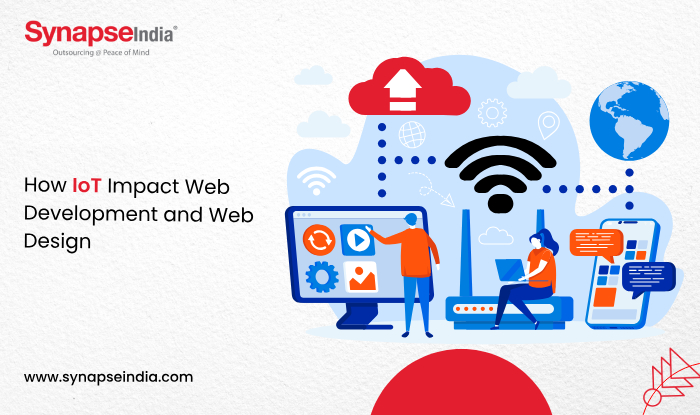 23 Nov 2024
23 Nov 2024“Learn how IoT is reshaping the future of web development. With IoT integration, businesses can optimize data processing, improve website speed, and provide seamless user interactions. This transformative technology enhances security, scalability, and user experience, making your web applications smarter and more efficient. ”

The Internet of Things (IoT) is a trending technology, bringing a revolutionary shift in the way we interact with the digital world. The transformation this technology has brought has not only affected different industries but also has a significant impact on web development and web design.
IoT has influenced how websites are developed and designed, creating new demands for developers, and reshaping the user experience. Integration of IoT in web development can help businesses remain competitive in an increasingly connected world, providing users with intuitive and responsive digital solutions.

The integration of IoT in web development offers numerous benefits, enhancing user experiences, enabling real-time data processing, and driving new business opportunities. The surging popularity of this technology is encouraging website designers to embrace IoT in web development. Let us explore the overall impact that IoT is having on web development and design.
One of the most critical aspects of IoT is the enormous volume of data generated by connected devices. Web developers must now deal with collecting, processing, and managing large datasets coming from IoT devices. Leveraging IoT, web developers can streamline data processing pipelines, optimize database systems, and execute real-time analytics for valuable insights.
Web applications that communicate with IoT devices require efficient data-handling mechanisms. Real-time data streams from sensors need to be captured, processed, and stored. Developers must implement robust data structures and storage systems that are scalable enough to accommodate an ever-growing number of devices.
Many IoT applications require data processing in real time or at least near real time to generate accurate insights. Web developers are increasingly integrating the latest protocols, message brokers, and event-driven architectures to ensure real-time interactions between the web interface and the IoT devices.
The integration of IoT in web development plays a crucial role in building resilient backends. IoT systems involve a vast number of interconnected devices that generate large amounts of data, requiring robust and scalable backend infrastructure.
A resilient backend for IoT-enabled websites must handle real-time data processing, ensuring minimal latency and high availability, even under heavy loads.
By leveraging cloud services and edge computing, IoT backends can dynamically scale to manage data traffic, reducing downtime and optimizing resource use. Additionally, IoT systems benefit from fault-tolerant architectures, mitigating the risk of single points of failure.
IoT backends also incorporate robust encryption, secure APIs, and stringent authentication measures to protect sensitive data and ensure safe communication between devices and web servers.
When IoT takes care of backend development , web developers can focus more on creating a visually appealing front end that attracts visitors and enhances retention.
As IoT ecosystems grow, web applications need to scale efficiently. A typical IoT system might involve thousands or millions of connected devices, all transmitting data to a central web application.
By leveraging cloud services such as AWS IoT, Microsoft Azure IoT, and Google Cloud IoT, web developers can manage the scalability challenges of IoT systems. Cloud-based infrastructures provide the necessary computing power, storage, and networking capabilities to handle the high volume of device-generated data.
Processing large amounts of information causes delays on networks. By facilitating data storage on the cloud rather than the network, IoT prevents any possible data loss due to issues in the networking infrastructure.
Cloud IoT services offer tools like load balancing and auto-scaling to ensure that the web applications can handle sudden spikes in device interactions.
IoT integration in website development can significantly boost web speed by optimizing data processing and reducing latency. By leveraging IoT devices and edge computing, data is processed closer to the source, minimizing the need to send large volumes of information to the centralized servers.
This reduces the load on web servers and speeds up the delivery of data to users. Web developers are working on optimizing edge-to-cloud communication to ensure that only relevant data is sent to the cloud, reducing bandwidth usage and improving response times.
The ability of IoT to unload tasks to edge computing reduces network congestion, allowing faster access to data. This results in quicker load times and overall improved web performance, especially in applications requiring real-time data.
IoT integration has brought attention to robust security and privacy measures, especially when handling large amounts of data transmitted by connected devices. This has encouraged web developers to adopt stronger encryption techniques and more secure data transfer protocols, benefiting both users and businesses.
Web developers are now incorporating more advanced encryption algorithms to protect data exchanged between IoT devices and web applications. Moreover, by tracking devices' movement and collecting user activity data, IoT can detect potential cyberattacks and enhance website privacy and security.
As a result, businesses can protect their customers' sensitive data, such as payment details and personal information, ensuring greater trust and brand loyalty.
IoT integration in website development has revolutionized user experience by enabling seamless interaction between users and connected devices. Websites can now provide personalized, real-time responses by leveraging data from IoT devices, enhancing convenience and interactivity.
IoT devices continuously collect data that can be analyzed to understand user behavior. This opens up opportunities for web applications to offer personalized experiences based on the collected data.
By enabling highly personalized and adaptive user experiences, IoT significantly enhances web design. With the ability to gather and process data from connected devices, web applications can adjust their interfaces and functionalities to match individual user preferences, leading to a more engaging and intuitive experience.
One of the most significant benefits of IoT in web design is the ability to create seamless multi-device experiences. IoT enables interconnected devices to work together, allowing users to transition effortlessly from one device to another. Web designers can leverage this capability to create cohesive, cross-platform user experiences that work harmoniously across various IoT devices.
IoT has a significant impact on user interface and user experience design, reshaping the way designers approach web-based interactions. The design must now cater to a more diverse set of devices, including smartphones, wearables, smart TVs, and home automation systems. With IoT, web design must go beyond traditional responsive design, which focuses on adapting websites to different screen sizes.
Many IoT devices have limited screen space or no screens at all, which requires web interfaces to only show the essential features. UI/UX designers are focusing on creating minimalist designs that allow users to interact with devices through simple and intuitive commands. The reduction of unnecessary elements improves loading times and usability, especially during interaction with low-powered devices.
Web designers must now account for interactions with devices that may not have a screen at all. These include voice assistants like Alexa, Google Home, and other smart appliances. With the rise of smart speakers, voice-controlled interfaces are becoming more important. Web developers are tasked with creating voice-compatible websites, where users can interact with the content through voice commands.
Chatbot integration is one of the most popular web development trends with IoT. IoT integration in website development significantly enhances chatbot functionality, creating smarter and more responsive conversational interfaces.
This integration enables chatbots to go beyond standard interactions by offering real-time insights, enhancing automation, and delivering seamless experiences. With IoT-driven chatbots, web developers can offer users more intelligent services, making websites more interactive and useful in connected environments.
APIs serve as the bridge between IoT devices and web applications, facilitating communication and data exchange. The development of IoT-ready APIs has become a key focus for developers, ensuring that web platforms can seamlessly interact with the vast array of connected devices.
Most web applications still rely on RESTful APIs for device communication, while some newer projects are adopting more advanced APIs to provide more efficient data querying capabilities. The flexibility and scalability of these APIs make them ideal for the dynamic needs of IoT environments. Middleware platforms, such as IoT gateways, help manage and optimize data flow between devices and web applications.

The integration of IoT into web development and web design is a transformative process that will continue to evolve in the coming years. Web developers are required to navigate a range of challenges, pushing the boundaries of traditional web development and necessitating new tools, frameworks, and approaches to handle the complexities of a hyper-connected world. In the future, we can expect further innovations in this technology, allowing web applications to provide even more powerful and responsive experiences. Web designers who can adapt to these changes will be at the forefront of creating the next generation of digital experiences.


